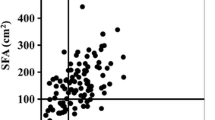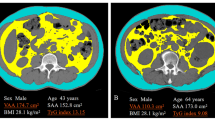Abstract
To elucidate the role of visceral fat accumulation in the metabolic syndrome, differences in the pathology of the metabolic syndrome with or without visceral fat accumulation were investigated. A total of 472 prediabetic Japanese men (mean age, 47.5±7.2 yr) with impaired fasting glycemia (IFG) levels of 110–125 mg/dL were eligible for participation in the study. The study subjects were divided into the following four groups, and intergroup comparisons were made: group I without visceral fat area [VFA]≥100 cm2 but presenting with fewer than two other risk factors (i.e., TG≥150 mg/dL, HDL-C<40 mg/dL, BP≥130/≥85 mmHg, or FPG≥110 mg/dL) (n=231); group II without VFA of ≥100 cm2 but presenting with three or more other risk factors (n=57); group III with VFA of ≥100 cm2 accompanied by FPG≥110 mg/dL alone (n=27); and group IV with VFA≥100 cm2 and two or more other risk factors (n=157). The prevalence of patients who had three or more risk factors with or without VFA≥100 cm2 was 45.3% (214 out of 472 patients), while that of those with VFA≥100 cm2 who had two or more other risk factors was 33% (157 out of 472 patients). Group II had significantly higher VFA values than group I (p<0.05), and group IV had significantly higher VFA values than group II (p<0.001). While no significant differences in HOMA-R values were seen between groups I and II, these values were significantly higher in group IV compared to groups I and II (p<0.001 and p<0.05, respectively). Furthermore, group IV showed significantly higher 2-h insulin levels after glucose loading compared to group I (p<0.001). While no significant differences were seen between groups II and IV, insulin levels tended to be higher in group IV. Adiponectin levels showed an incremental fall in VFA from group I through groups II and III to group IV. Groups III and IV showed significantly lower adiponectin levels compared to group I (p<0.05, p<0.001, respectively); and group IV showed significantly lower adiponectin levels than group II (p<0.05). A logistic regression analysis using VFA, TG and HDL-C, and BP as explanatory variables showed that the relative risk for high HOMA-R values were 2.65 (p<0.001) for patients with VFA ≥100 cm2; 1.64 (p<0.05) for those with TG≥150 mg/dL and HDL<40 mg/dL; and 1.79 (p<0.01) for those with BP≥130/≥85 mmHg. These findings demonstrate that the degree of insulin resistance and the risk of arteriosclerosis vary depending on whether or not the metabolic syndrome accompanied by a clustering of risk factors has visceral fat accumulation as an underlying pathology, strongly suggesting a crucial role for visceral fat accumulation in the metabolic syndrome.
Similar content being viewed by others
References
Third report of the National Cholesterol Education Program (NCEP) expert panel on detection, evaluation, and treatment of high blood cholesterol in adults (Adult Treatment Panel III). Final report. (2002). Circulation 106, 3143–3421.
World Health Organization (1999). Definition, diagnosis and classification of diabetes and its complications; report of a WHO Consultation. Part I: diagnosis and classification of diabetes mellitus. World Health Organization. Geneva, Switzerland; available at http://wholibdoc.who.int/hq/1999/WHO NCD 99.2.pdf. Accessed December 12, 2003
The Examination Committee on Diagnostic Criteria for Metabolic Syndrome (2005). J. Jpn. Soc. Intern. Med. 94, 188–203 (in Japanese).
International Diabetes Federation. The IDF Consensus: world-wide definition of the metabolic syndrome. www.idf.org. VAT BE433.674.528.
The Examination Committee of Criteria for “Obesity Disease” in Japan, Japan Society for the Study of Obesity (2002). Circ. J. 66, 987–992.
Maeda, K., Okubo, K., Shimomura, I., Funahashi, T., Matsuzawa, Y., and Matsubara, K. (1996). Biochem. Biophys. Res. Commun. 221, 286–289.
Ryo, M., Nakamura, T., Kihara, S., et al. (2004). Circ. J. 68, 975–981.
Hotta, K., Funahashi, T., Bodkin, N. L. et al. (2001). Diabetes 50, 1126–1133.
Ouchi, N., Kihara, S., Arita, Y., et al. (1999). Circulation 100, 2473–2476.
Kumada, M., Kihara, S., Sumitsuji, S., et al. (2003). Arterioscler. Throm. Vasc. Biol. 23, 85–89.
Wajchenberg, B. L. (2000). Endocrine Rev. 21, 697–738.
Carr, D. B., Utzschneider, K. M., Hull, R. L., et al. (2004). Diabetes 53, 2087–2094.
Stout, R. W. (1990). Diabetes Care 13, 631–654.
Balletshofer, B. M., Rittig, K., Enderle, M. D., et al. (2000). Circulation 101, 1780–1784.
Matthews, D. R., Hosker, J. P., Rudenski, A. S., Naylor, B. A., Treacher, D. F., and Turner, R. C. (1985). Diabetologia 28, 412–419.
Yoshizumi, T., Nakamura, M., Yamane, A. M., et al. (1999). Radiology 211, 283–286.
Author information
Authors and Affiliations
Corresponding author
Rights and permissions
About this article
Cite this article
Mori, Y., Hoshino, K., Yokota, K. et al. Differences in the pathology of the metabolic syndrome with or without visceral fat accumulation. Endocr 29, 149–153 (2006). https://doi.org/10.1385/ENDO:29:1:149
Received:
Revised:
Accepted:
Issue Date:
DOI: https://doi.org/10.1385/ENDO:29:1:149




